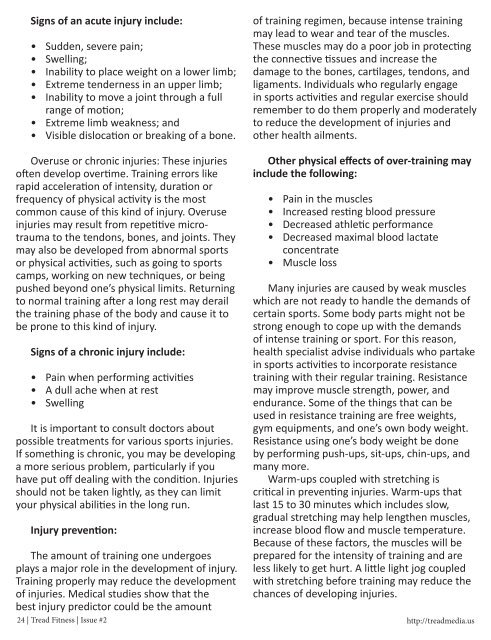Tread Fitness Issue 02
Tread Fitness covers all aspects of our health and fitness, including exercise, nutrition, recipes and more. In this issue: Women and Weights, Injury Prevention, Calf Cramps, Exercise and Water, Acid Reflux, Exercise and Stress, Become a Healthy Eater, Supplement Buying Tips, and more.
Tread Fitness covers all aspects of our health and fitness, including exercise, nutrition, recipes and more. In this issue: Women and Weights, Injury Prevention, Calf Cramps, Exercise and Water, Acid Reflux, Exercise and Stress, Become a Healthy Eater, Supplement Buying Tips, and more.
Create successful ePaper yourself
Turn your PDF publications into a flip-book with our unique Google optimized e-Paper software.
Signs of an acute injury include:<br />
• Sudden, severe pain;<br />
• Swelling;<br />
• Inability to place weight on a lower limb;<br />
• Extreme tenderness in an upper limb;<br />
• Inability to move a joint through a full<br />
range of motion;<br />
• Extreme limb weakness; and<br />
• Visible dislocation or breaking of a bone.<br />
of training regimen, because intense training<br />
may lead to wear and tear of the muscles.<br />
These muscles may do a poor job in protecting<br />
the connective tissues and increase the<br />
damage to the bones, cartilages, tendons, and<br />
ligaments. Individuals who regularly engage<br />
in sports activities and regular exercise should<br />
remember to do them properly and moderately<br />
to reduce the development of injuries and<br />
other health ailments.<br />
Overuse or chronic injuries: These injuries<br />
often develop overtime. Training errors like<br />
rapid acceleration of intensity, duration or<br />
frequency of physical activity is the most<br />
common cause of this kind of injury. Overuse<br />
injuries may result from repetitive microtrauma<br />
to the tendons, bones, and joints. They<br />
may also be developed from abnormal sports<br />
or physical activities, such as going to sports<br />
camps, working on new techniques, or being<br />
pushed beyond one’s physical limits. Returning<br />
to normal training after a long rest may derail<br />
the training phase of the body and cause it to<br />
be prone to this kind of injury.<br />
Signs of a chronic injury include:<br />
• Pain when performing activities<br />
• A dull ache when at rest<br />
• Swelling<br />
It is important to consult doctors about<br />
possible treatments for various sports injuries.<br />
If something is chronic, you may be developing<br />
a more serious problem, particularly if you<br />
have put off dealing with the condition. Injuries<br />
should not be taken lightly, as they can limit<br />
your physical abilities in the long run.<br />
Injury prevention:<br />
The amount of training one undergoes<br />
plays a major role in the development of injury.<br />
Training properly may reduce the development<br />
of injuries. Medical studies show that the<br />
best injury predictor could be the amount<br />
Other physical effects of over-training may<br />
include the following:<br />
• Pain in the muscles<br />
• Increased resting blood pressure<br />
• Decreased athletic performance<br />
• Decreased maximal blood lactate<br />
concentrate<br />
• Muscle loss<br />
Many injuries are caused by weak muscles<br />
which are not ready to handle the demands of<br />
certain sports. Some body parts might not be<br />
strong enough to cope up with the demands<br />
of intense training or sport. For this reason,<br />
health specialist advise individuals who partake<br />
in sports activities to incorporate resistance<br />
training with their regular training. Resistance<br />
may improve muscle strength, power, and<br />
endurance. Some of the things that can be<br />
used in resistance training are free weights,<br />
gym equipments, and one’s own body weight.<br />
Resistance using one’s body weight be done<br />
by performing push-ups, sit-ups, chin-ups, and<br />
many more.<br />
Warm-ups coupled with stretching is<br />
critical in preventing injuries. Warm-ups that<br />
last 15 to 30 minutes which includes slow,<br />
gradual stretching may help lengthen muscles,<br />
increase blood flow and muscle temperature.<br />
Because of these factors, the muscles will be<br />
prepared for the intensity of training and are<br />
less likely to get hurt. A little light jog coupled<br />
with stretching before training may reduce the<br />
chances of developing injuries.<br />
24 | <strong>Tread</strong> <strong>Fitness</strong> | <strong>Issue</strong> #2 http://treadmedia.us





